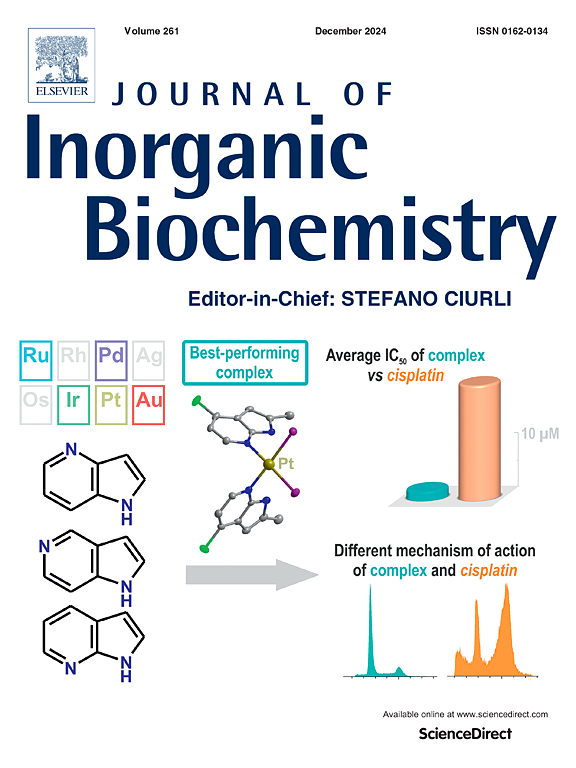Antiproliferative activity in breast cancer cells of PtL2: A steroid-thiosemicarbazone platinum(II) complex
IF 3.2
2区 化学
Q2 BIOCHEMISTRY & MOLECULAR BIOLOGY
引用次数: 0
Abstract
Breast cancer remains one of the most diagnosed cancers in women worldwide. Metallodrugs such as cisplatin are used in advanced stages and hormone independent tumors. We hereby report the synthesis and characterization of a new benzaldehyde thiosemicarbazone functionalized with an estradiol derivative, LH, and two metal complexes, PdCl2(LH) and PtL2. Both complexes were studied in solution showing enough stability to further perform antitumoral activity studies. The Pd(II) complex was discarded for its poor performance while PtL₂ exhibited similar cytotoxic activity to cisplatin (CDDP) in estrogen receptor (+) and triple-negative breast cancer cells. Moreover, PtL₂ demonstrated reduced toxicity in healthy cell lines. It induced cell cycle arrest at the G0/G1 phase, distinguishing its mechanism of action from CDDP, which predominantly blocks cells in the S phase. Additionally, PtL₂ displayed a balanced intracellular distribution between the nucleus and cytoplasm, independent of estrogen receptor status. Further analysis revealed that PtL₂ dysregulated antioxidant enzyme expression, potentially disrupting redox homeostasis. These findings highlight PtL₂’s potential as a promising alternative to conventional platinum-based therapies, warranting further investigation into its molecular mechanisms and therapeutic applications.

PtL2在乳腺癌细胞中的抗增殖活性:一种类固醇-硫代氨基脲-铂(II)复合物
乳腺癌仍然是全世界女性中诊断最多的癌症之一。金属药物如顺铂用于晚期和不依赖激素的肿瘤。我们在此报道了一种新的由雌二醇衍生物LH和两个金属配合物PdCl2(LH)和PtL2功能化的苯甲醛硫代氨基脲的合成和表征。这两种复合物都在溶液中进行了研究,显示出足够的稳定性,可以进一步进行抗肿瘤活性研究。Pd(II)复合物因其性能不佳而被丢弃,而PtL₂在雌激素受体(+)和三阴性乳腺癌细胞中表现出与顺铂(CDDP)相似的细胞毒活性。此外,PtL 2在健康细胞系中显示出毒性降低。它在G0/G1期诱导细胞周期阻滞,其作用机制与CDDP不同,CDDP主要阻断S期细胞。此外,PtL 2在细胞核和细胞质之间的细胞内分布平衡,不受雌激素受体状态的影响。进一步的分析表明,PtL 2失调了抗氧化酶的表达,潜在地破坏了氧化还原稳态。这些发现突出了PtL 2作为传统铂基疗法的有希望的替代品的潜力,值得进一步研究其分子机制和治疗应用。
本文章由计算机程序翻译,如有差异,请以英文原文为准。
求助全文
约1分钟内获得全文
求助全文
来源期刊

Journal of Inorganic Biochemistry
生物-生化与分子生物学
CiteScore
7.00
自引率
10.30%
发文量
336
审稿时长
41 days
期刊介绍:
The Journal of Inorganic Biochemistry is an established international forum for research in all aspects of Biological Inorganic Chemistry. Original papers of a high scientific level are published in the form of Articles (full length papers), Short Communications, Focused Reviews and Bioinorganic Methods. Topics include: the chemistry, structure and function of metalloenzymes; the interaction of inorganic ions and molecules with proteins and nucleic acids; the synthesis and properties of coordination complexes of biological interest including both structural and functional model systems; the function of metal- containing systems in the regulation of gene expression; the role of metals in medicine; the application of spectroscopic methods to determine the structure of metallobiomolecules; the preparation and characterization of metal-based biomaterials; and related systems. The emphasis of the Journal is on the structure and mechanism of action of metallobiomolecules.
 求助内容:
求助内容: 应助结果提醒方式:
应助结果提醒方式:


